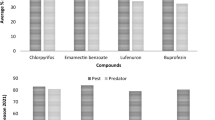Abstract
In many places in the tropics pesticides are applied in the natural environment to control insects either for crop protection, or for human health. The present study concerns the side-effects of insecticides that are applied in West Africa against tsetseflies (Glossina spp), which are the vectors of human and animal sleeping sickness. Pyrethroids and endosulfan were sprayed either by helicopter or by ground spraying on riverine forests and on forests around villages.
Because of the complexity of the terrestrial and aquatic ecosystems under study, a selection was made of populations in which side-effects were assessed (so-called indicators). Fish and benthic arthropods were studied in the rivers; Diptera, Hymenoptera and spiders in the forest. Observations on short-term effects revealed the most vulnerable populations (indicators for effects) depending on the insecticide and the method of application. Long-term studies, up to two years, revealed the differences amongst these populations in ability to recover from local depletion. The populations which recovered most slowly were regarded as indicators for recovery.
Differences in hydrological regime between climatic zones are regarded to be highly related to differences in vulnerability of ecosystems to irreversible damage by pesticides.
Similar content being viewed by others
References
Baars, M. A.: 1981, ‘Patterns of Movement of Radioactive Carabid Beetles’, Oecologia (Berl.) 44, 125–140.
Everts, J. W., Frankenhuijzen, K. van, Roman, B., and Koeman, J. H.: 1983, ‘Observations on Side-Effects of Experimental Pyrethroid Applications for the Control of Tsetseflies in a Riverine Forest Habitat’, Arch. Environm. Contam. Toxicol. 12, 91–97.
Green, R. H.: 1978, ‘Optimal Impact Study Design and Analysis’, in: K. L. Dickson, John Cairns, Jr., and R. J. Livingston (eds.), Biological Data in Water Pollution Assessment: Quantitative & Statistical Analyses, ASTM STP 652 pp., 3–28.
Koeman, J. H., Boer, W. M. J. den, Feith, A. F., Iongh, H. H. de, Spliethof, P., Na'Isa, B. K., and Spielberger, U.: 1978, ‘Three Years' Observation on Side Effects of Helicopter Applications of Insecticides Used to Exterminate Glossina Species in Nigeria’, Environ. Pollut. 15, 31–59.
Müller, P., Nagel, P., and Flacke, W.: 1980, ‘Oekologischer Einfluss von Tsetsefliegenbekämpfung mit Dieldrin im Hochland van Adamaoua (Kamerun)’, Amazonia VII, I, 31–48.
Russel-Smith, A.: 1981, ‘The Effects of Aerial Spraying of Endosulfan for Tsetse Fly Control on Aquatic Invertebrates in the Okavango Swamps, Botswana’, Environ. Pollut. (series A) 24, 57–73.
Smies, R., Evers, R. H. J., Peijnenburg, F. H. M., and Koeman, J. H.: 1980, ‘Environmental Aspects of Field Trials with Pyrethroids to Eradicate Tsetse Fly in Nigeria’, Ecotoxicol. and Environ. Safety 4, 114–128.
Takken, W., Balk, F., Jansen, R. C., and Koeman, J. H.: 1978, ‘The Experimental Application of Insecticides from a Helicopter for the Control of Riverine Populations of Glossina tachinoides in West Africa VI. Observations on Side-Effects’, Pest and Agriculture News Summary 24, 455–466.
Author information
Authors and Affiliations
Rights and permissions
About this article
Cite this article
Everts, J.W. Animal indicators for side-effects of chemical vector control. Environ Monit Assess 3, 229–236 (1983). https://doi.org/10.1007/BF00396216
Received:
Issue Date:
DOI: https://doi.org/10.1007/BF00396216



